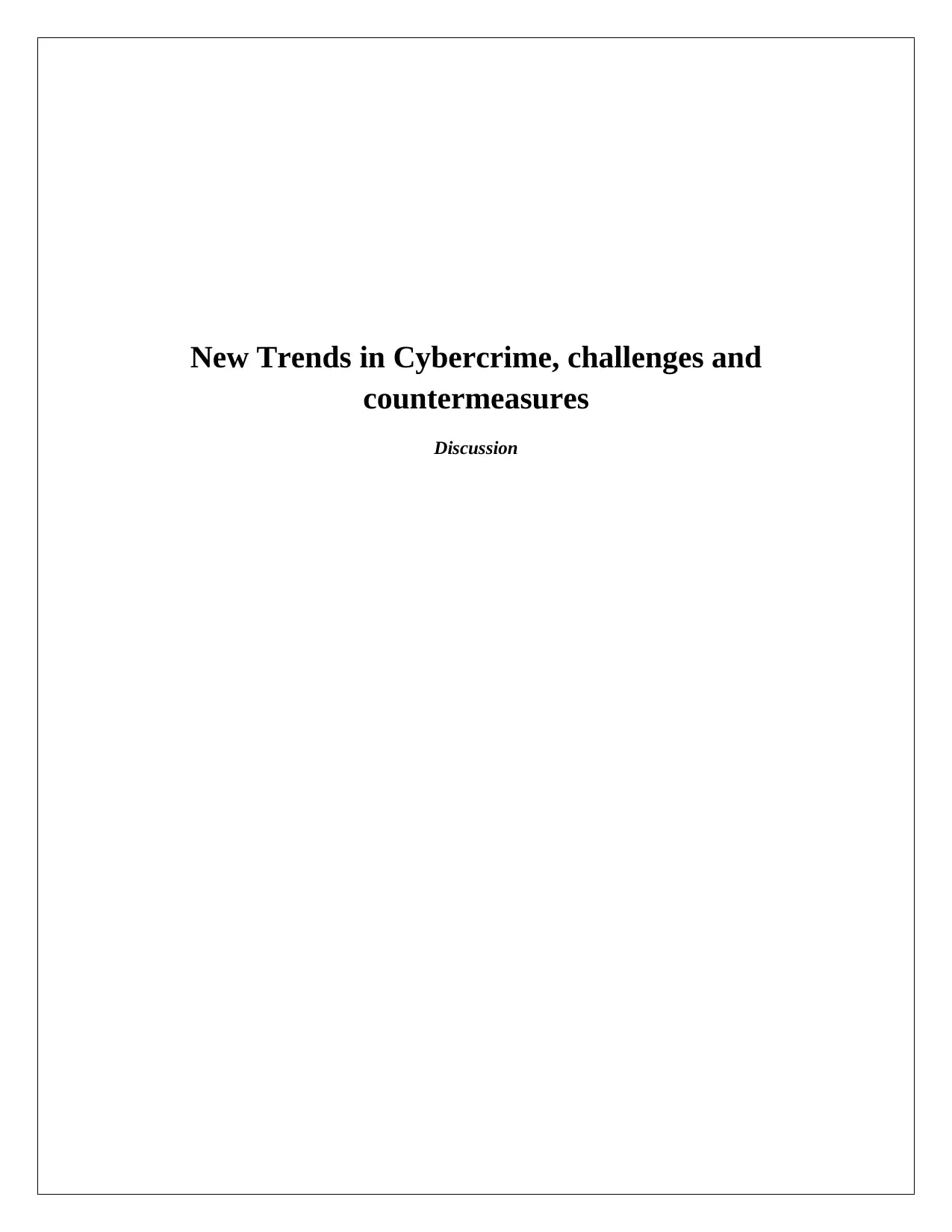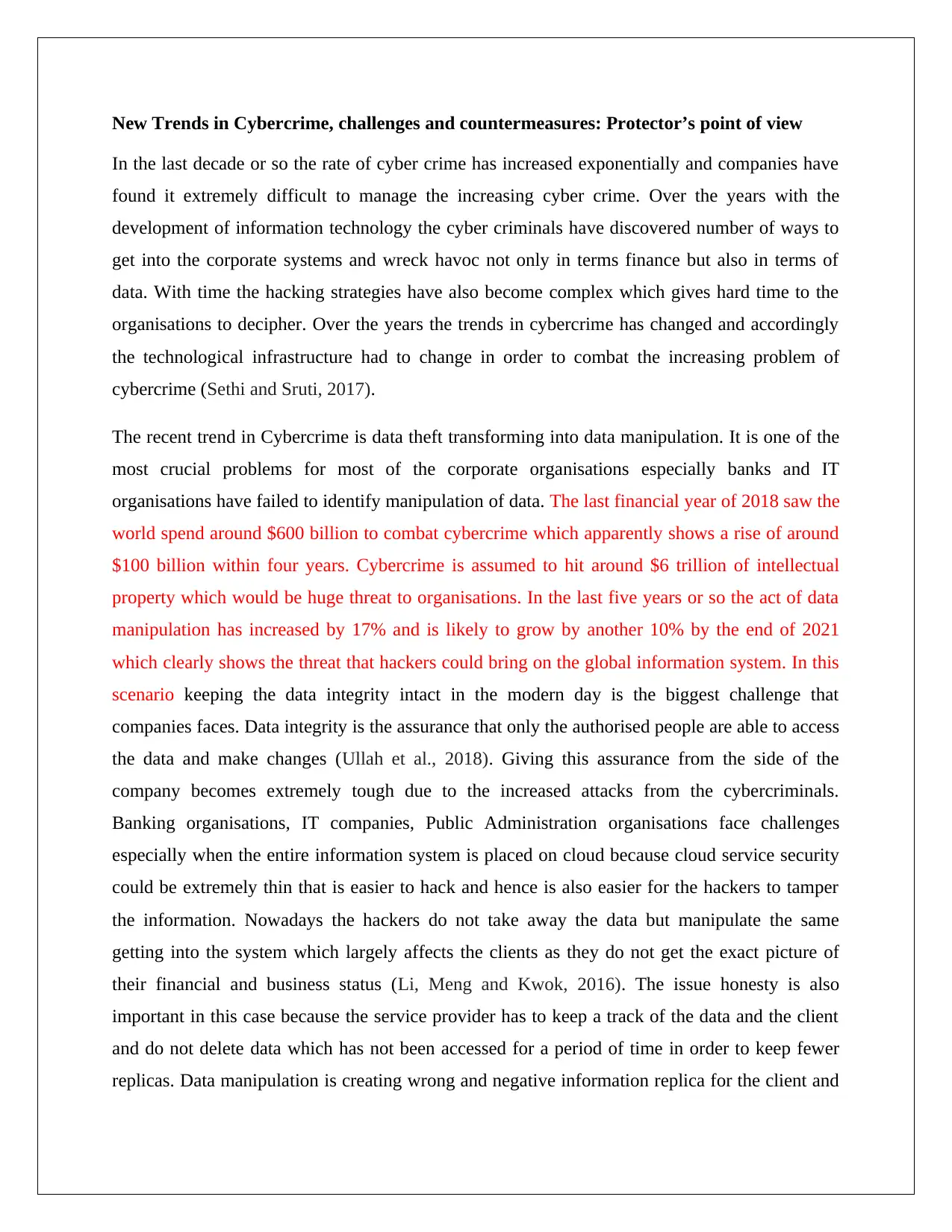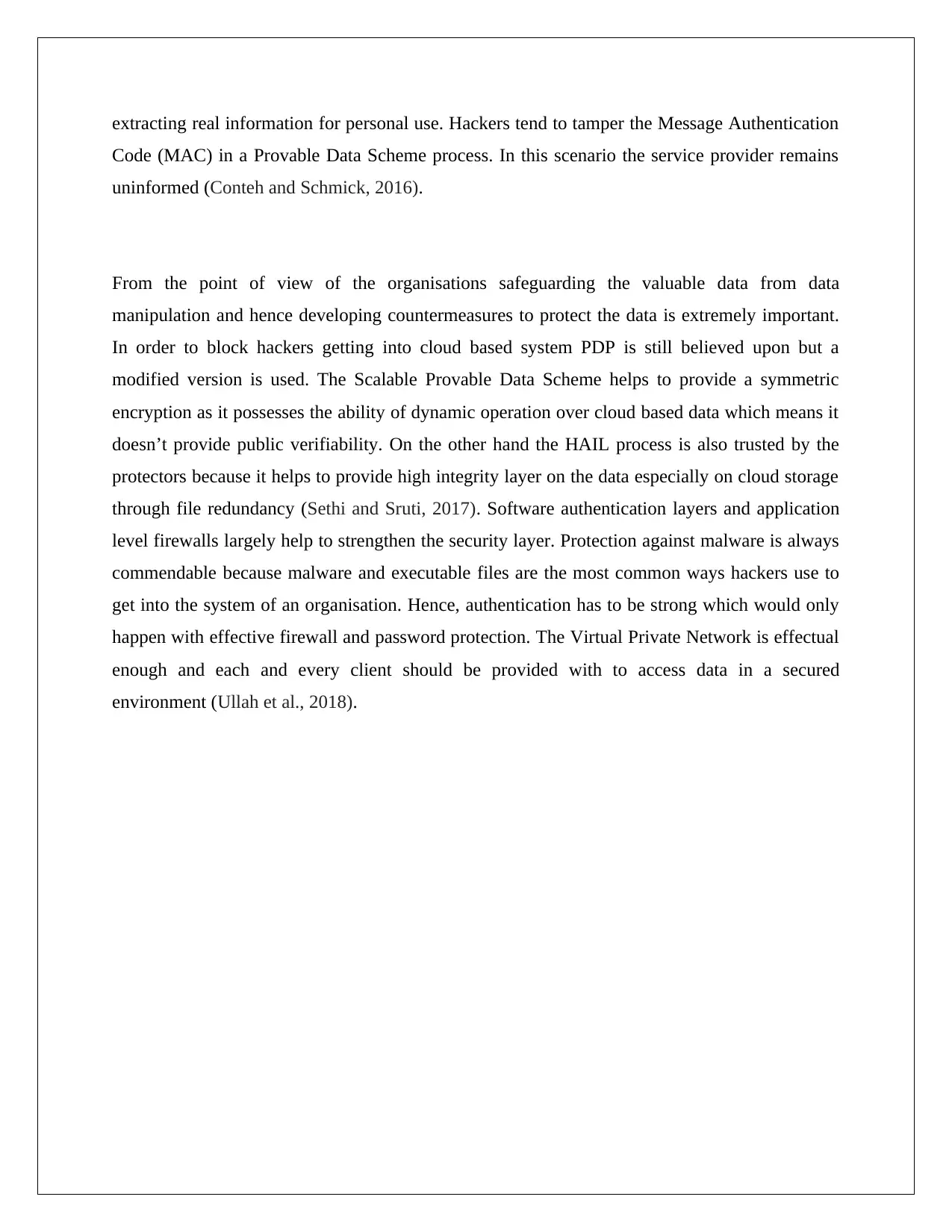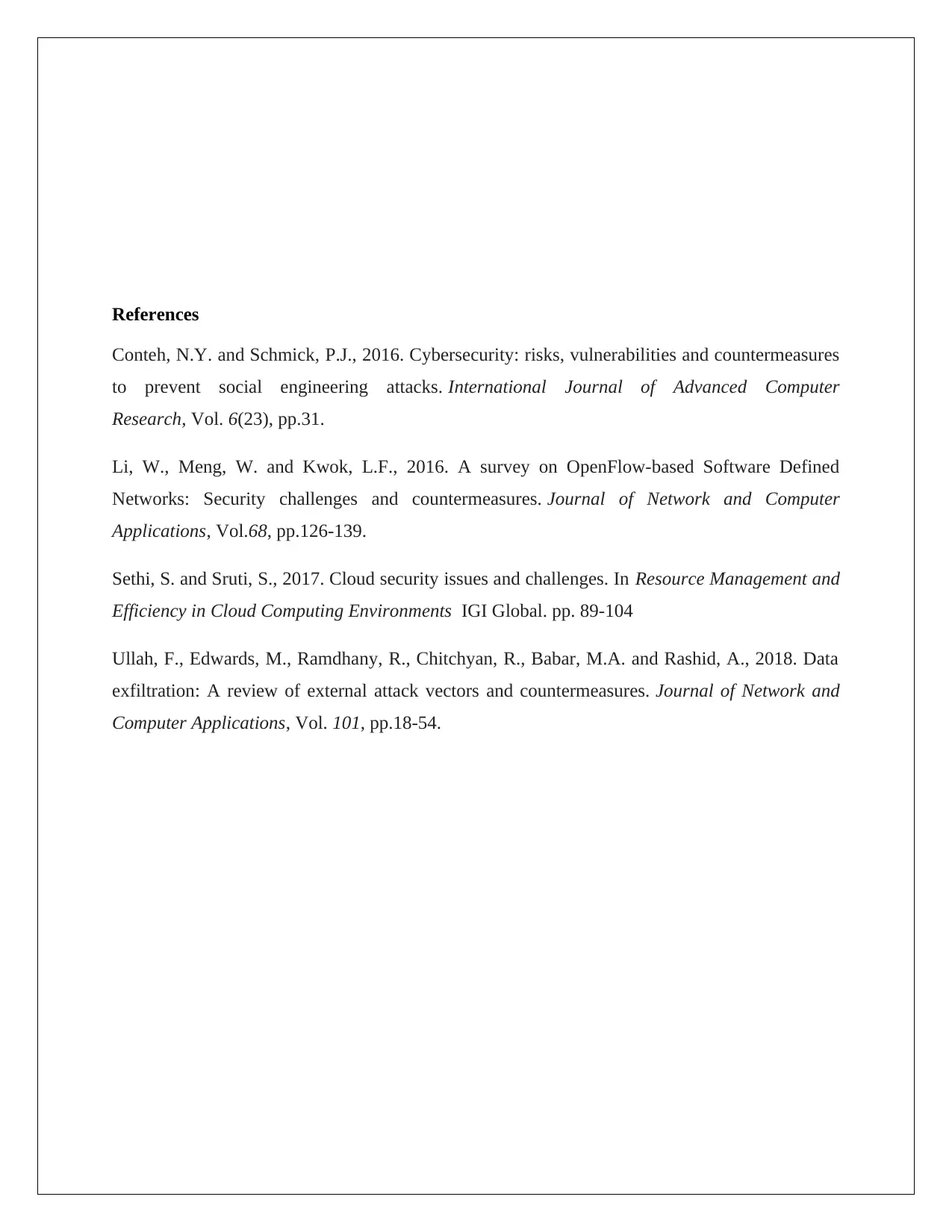Exploring New Trends in Cybercrime: Challenges and Countermeasures
VerifiedAdded on 2023/04/20
|4
|914
|337
Essay
AI Summary
This essay discusses the evolving trends in cybercrime, particularly the shift towards data manipulation, and the challenges organizations face in maintaining data integrity. The financial impact of cybercrime is highlighted, along with the increasing sophistication of hacking strategies. The essay explores countermeasures such as Scalable Provable Data Possession (PDP) schemes, HAIL process, software authentication layers, application-level firewalls, and virtual private networks (VPNs) as potential solutions to safeguard valuable data, especially in cloud-based systems. It emphasizes the importance of strong authentication and protection against malware to mitigate the risks associated with cyber attacks.

New Trends in Cybercrime, challenges and
countermeasures
Discussion
countermeasures
Discussion
Paraphrase This Document
Need a fresh take? Get an instant paraphrase of this document with our AI Paraphraser

New Trends in Cybercrime, challenges and countermeasures: Protector’s point of view
In the last decade or so the rate of cyber crime has increased exponentially and companies have
found it extremely difficult to manage the increasing cyber crime. Over the years with the
development of information technology the cyber criminals have discovered number of ways to
get into the corporate systems and wreck havoc not only in terms finance but also in terms of
data. With time the hacking strategies have also become complex which gives hard time to the
organisations to decipher. Over the years the trends in cybercrime has changed and accordingly
the technological infrastructure had to change in order to combat the increasing problem of
cybercrime (Sethi and Sruti, 2017).
The recent trend in Cybercrime is data theft transforming into data manipulation. It is one of the
most crucial problems for most of the corporate organisations especially banks and IT
organisations have failed to identify manipulation of data. The last financial year of 2018 saw the
world spend around $600 billion to combat cybercrime which apparently shows a rise of around
$100 billion within four years. Cybercrime is assumed to hit around $6 trillion of intellectual
property which would be huge threat to organisations. In the last five years or so the act of data
manipulation has increased by 17% and is likely to grow by another 10% by the end of 2021
which clearly shows the threat that hackers could bring on the global information system. In this
scenario keeping the data integrity intact in the modern day is the biggest challenge that
companies faces. Data integrity is the assurance that only the authorised people are able to access
the data and make changes (Ullah et al., 2018). Giving this assurance from the side of the
company becomes extremely tough due to the increased attacks from the cybercriminals.
Banking organisations, IT companies, Public Administration organisations face challenges
especially when the entire information system is placed on cloud because cloud service security
could be extremely thin that is easier to hack and hence is also easier for the hackers to tamper
the information. Nowadays the hackers do not take away the data but manipulate the same
getting into the system which largely affects the clients as they do not get the exact picture of
their financial and business status (Li, Meng and Kwok, 2016). The issue honesty is also
important in this case because the service provider has to keep a track of the data and the client
and do not delete data which has not been accessed for a period of time in order to keep fewer
replicas. Data manipulation is creating wrong and negative information replica for the client and
In the last decade or so the rate of cyber crime has increased exponentially and companies have
found it extremely difficult to manage the increasing cyber crime. Over the years with the
development of information technology the cyber criminals have discovered number of ways to
get into the corporate systems and wreck havoc not only in terms finance but also in terms of
data. With time the hacking strategies have also become complex which gives hard time to the
organisations to decipher. Over the years the trends in cybercrime has changed and accordingly
the technological infrastructure had to change in order to combat the increasing problem of
cybercrime (Sethi and Sruti, 2017).
The recent trend in Cybercrime is data theft transforming into data manipulation. It is one of the
most crucial problems for most of the corporate organisations especially banks and IT
organisations have failed to identify manipulation of data. The last financial year of 2018 saw the
world spend around $600 billion to combat cybercrime which apparently shows a rise of around
$100 billion within four years. Cybercrime is assumed to hit around $6 trillion of intellectual
property which would be huge threat to organisations. In the last five years or so the act of data
manipulation has increased by 17% and is likely to grow by another 10% by the end of 2021
which clearly shows the threat that hackers could bring on the global information system. In this
scenario keeping the data integrity intact in the modern day is the biggest challenge that
companies faces. Data integrity is the assurance that only the authorised people are able to access
the data and make changes (Ullah et al., 2018). Giving this assurance from the side of the
company becomes extremely tough due to the increased attacks from the cybercriminals.
Banking organisations, IT companies, Public Administration organisations face challenges
especially when the entire information system is placed on cloud because cloud service security
could be extremely thin that is easier to hack and hence is also easier for the hackers to tamper
the information. Nowadays the hackers do not take away the data but manipulate the same
getting into the system which largely affects the clients as they do not get the exact picture of
their financial and business status (Li, Meng and Kwok, 2016). The issue honesty is also
important in this case because the service provider has to keep a track of the data and the client
and do not delete data which has not been accessed for a period of time in order to keep fewer
replicas. Data manipulation is creating wrong and negative information replica for the client and

extracting real information for personal use. Hackers tend to tamper the Message Authentication
Code (MAC) in a Provable Data Scheme process. In this scenario the service provider remains
uninformed (Conteh and Schmick, 2016).
From the point of view of the organisations safeguarding the valuable data from data
manipulation and hence developing countermeasures to protect the data is extremely important.
In order to block hackers getting into cloud based system PDP is still believed upon but a
modified version is used. The Scalable Provable Data Scheme helps to provide a symmetric
encryption as it possesses the ability of dynamic operation over cloud based data which means it
doesn’t provide public verifiability. On the other hand the HAIL process is also trusted by the
protectors because it helps to provide high integrity layer on the data especially on cloud storage
through file redundancy (Sethi and Sruti, 2017). Software authentication layers and application
level firewalls largely help to strengthen the security layer. Protection against malware is always
commendable because malware and executable files are the most common ways hackers use to
get into the system of an organisation. Hence, authentication has to be strong which would only
happen with effective firewall and password protection. The Virtual Private Network is effectual
enough and each and every client should be provided with to access data in a secured
environment (Ullah et al., 2018).
Code (MAC) in a Provable Data Scheme process. In this scenario the service provider remains
uninformed (Conteh and Schmick, 2016).
From the point of view of the organisations safeguarding the valuable data from data
manipulation and hence developing countermeasures to protect the data is extremely important.
In order to block hackers getting into cloud based system PDP is still believed upon but a
modified version is used. The Scalable Provable Data Scheme helps to provide a symmetric
encryption as it possesses the ability of dynamic operation over cloud based data which means it
doesn’t provide public verifiability. On the other hand the HAIL process is also trusted by the
protectors because it helps to provide high integrity layer on the data especially on cloud storage
through file redundancy (Sethi and Sruti, 2017). Software authentication layers and application
level firewalls largely help to strengthen the security layer. Protection against malware is always
commendable because malware and executable files are the most common ways hackers use to
get into the system of an organisation. Hence, authentication has to be strong which would only
happen with effective firewall and password protection. The Virtual Private Network is effectual
enough and each and every client should be provided with to access data in a secured
environment (Ullah et al., 2018).
⊘ This is a preview!⊘
Do you want full access?
Subscribe today to unlock all pages.

Trusted by 1+ million students worldwide

References
Conteh, N.Y. and Schmick, P.J., 2016. Cybersecurity: risks, vulnerabilities and countermeasures
to prevent social engineering attacks. International Journal of Advanced Computer
Research, Vol. 6(23), pp.31.
Li, W., Meng, W. and Kwok, L.F., 2016. A survey on OpenFlow-based Software Defined
Networks: Security challenges and countermeasures. Journal of Network and Computer
Applications, Vol.68, pp.126-139.
Sethi, S. and Sruti, S., 2017. Cloud security issues and challenges. In Resource Management and
Efficiency in Cloud Computing Environments IGI Global. pp. 89-104
Ullah, F., Edwards, M., Ramdhany, R., Chitchyan, R., Babar, M.A. and Rashid, A., 2018. Data
exfiltration: A review of external attack vectors and countermeasures. Journal of Network and
Computer Applications, Vol. 101, pp.18-54.
Conteh, N.Y. and Schmick, P.J., 2016. Cybersecurity: risks, vulnerabilities and countermeasures
to prevent social engineering attacks. International Journal of Advanced Computer
Research, Vol. 6(23), pp.31.
Li, W., Meng, W. and Kwok, L.F., 2016. A survey on OpenFlow-based Software Defined
Networks: Security challenges and countermeasures. Journal of Network and Computer
Applications, Vol.68, pp.126-139.
Sethi, S. and Sruti, S., 2017. Cloud security issues and challenges. In Resource Management and
Efficiency in Cloud Computing Environments IGI Global. pp. 89-104
Ullah, F., Edwards, M., Ramdhany, R., Chitchyan, R., Babar, M.A. and Rashid, A., 2018. Data
exfiltration: A review of external attack vectors and countermeasures. Journal of Network and
Computer Applications, Vol. 101, pp.18-54.
1 out of 4
Related Documents
Your All-in-One AI-Powered Toolkit for Academic Success.
+13062052269
info@desklib.com
Available 24*7 on WhatsApp / Email
![[object Object]](/_next/static/media/star-bottom.7253800d.svg)
Unlock your academic potential
Copyright © 2020–2025 A2Z Services. All Rights Reserved. Developed and managed by ZUCOL.




